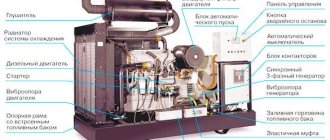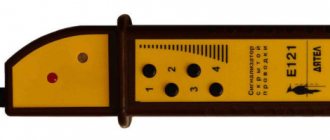I. General information
The design of vacuum circuit breakers of the BB/TEL series is based on the principle of using phase-by-phase electromagnetic drives with a “magnetic latch”. This means that in the closed state of the switch, the main circuit contacts are kept closed due to the magnetic field created during the closing process of the switch. Naturally, to create a magnetic field you need an energy source.
Such energy sources are:
- Operational power supply circuits for switchgears (RU, KRU, KRUN) 6, 10 kV system, regional, city, rural substations.
- Operational power supply circuits for distribution devices, points, transformer substations (RU, RP, TRP, TP) 6, 10 kV industrial and agricultural enterprises, city and regional electrical networks.
- Autonomous switching units (product of Tavrida Electric Ukraine Enterprise LLC) or a portable 12-24 V battery, with the help of which the BB/TEL switch of the input cell is first turned on, voltage of 6, 10 kV is supplied to the busbars and the subsequent formation of operational circuits nutrition.
In other words, for the normal functioning of BB/TEL series switches, auxiliary power is required. According to the type of auxiliary power source, all switchgear, switchgear, switchgear, RP, TRP, 6, 10 kV transformer substations are divided into two main groups:
- Switchgears with constant (rectified) operating voltage 24, 48, 110, 220 V. These are, as a rule, RU 6, 10 kV system substations 330, 220, 110 kV, regional and large city substations 110, 35 kV (power transformers substations 10 MVA and above), switchgear, distribution point 6, 10 kV of large industrial enterprises.
Sources of constant operational voltage are batteries with a charging rectifier. Operational rectified voltage 110, 220 V is used at small regional, city substations of 110, 35 kV, RP, 6.10 kV enterprises, less often in RU, 6.10 kV urban substations electrical networks and rural substations 35 kV.The main sources of rectified operational voltage are circuit bundles of power supplies:
a) power supplies for voltage BPN-1002 and current BPT-1002; b) power supplies stabilized for voltage BPNS and current BPT-1002; c) power supply devices stabilized by voltage UPNS and current BPT-1002.
As a rule, voltage power supply units and devices are connected to auxiliary transformers of substations, RP, RU 6 10 kV, which in turn are connected according to the circuit up to the switchgear input switch. Current power supplies are connected to the secondary windings of current transformers of RU 6, 10 kV input cells, current transformers installed on 6, 10 kV busbars, current transformers on the 35, 110 kV side. A circuit connection of blocks, voltage and current power devices is necessary to ensure guaranteed power supply to relay protection and automation circuits, secondary switching circuits BB/TEL, in emergency modes (close short circuits, voltage dips). Features of connecting BB/TEL control units to operational circuits at direct and rectified voltage are discussed below.
- Switchgears with variable operating voltage 100, 220 V. These are, as a rule, standard urban and rural substations of 35 kV, less often 110 kV (power transformers capacity 1.6, 2.5, 4.0, 6.3, 10.0 MVA), RU, RP, TRP, TP 6, 10 kV of small and medium-sized enterprises, city electrical networks.
Sources of alternating operating voltage are:
a) auxiliary transformers TSN 6, 10/0.4 kV with a capacity of 16, 25, 40 kVA; b) power transformers 6, 10/0.4 kV TRP, TP with a capacity of 250-2500 kVA; c) measuring voltage transformers NTMI, NOM, NAMIT, NAMI 6-10 kV; d) low-power auxiliary transformers of type 0LS, 0LM-063 (1.25) kVA 6, 10 kV/100, 220 V.
According to the connection diagram, operational alternating voltage sources are divided into two groups:
- The source is connected to the input switch of the 6, 10 kV switchgear substation, switchgear, distribution point, distribution center of enterprises, city electrical networks.
This is a standard circuit that ensures the formation of operational voltage when the power transformer of a substation is turned on or a voltage of 6, 10 kV appears at the input cell of the switchgear, relay point, or relay point. The provided operational power allows normal operation of switches of input cells and cells of outgoing lines with BB/TEL. - The source is connected from the busbars of the 6, 10 kV switchgear.
Less common. As a rule, these are switchgear of enterprises, city electrical networks built and commissioned in the 70-80s of the last century. This scheme provided for the “manual” activation of the input switch on the unloaded section of the busbars, connecting a source to them and generating operational voltage in the switchgear. To turn on the BB/TEL input cell, an autonomous source is required. For example, an autonomous switching unit (a product manufactured by Tavrida Electric Ukraine Enterprise LLC) or a portable 12-24 V battery. The features of connecting BB/TEL control units to operational alternating voltage are discussed below. Everything discussed above applies to substations, switchgears, distribution centers, and distribution centers with operational power supply.In practice, 6 and 10 kV switchgears are often encountered without auxiliary power supply. These are urban distribution centers, distribution centers, switchgears of 6, 10 kV enterprises, small rural substations of 35 kV, which were built and put into operation in the 50-70s of the last century. The cells of these switchgears are equipped with load switches, oil switches with manual, manual load or spring drive and direct-acting protections such as RTV, RTM, RNV. When the question arises about upgrading them using BB/TEL vacuum switches, the question naturally arises about choosing a source and forming operational circuits, as well as choosing relay protection equipment, since BB/TEL does not work with direct-acting relays. Also, this issue is relevant when designing new 6, 10 kV switchgears, in which BB/TEL are selected as switching devices. Some options for forming operational circuits of a switchgear, choosing the optimal BB/TEL control unit and its connection features are discussed below.










